Stroke is a medical emergency. This video highlights a patient and family member’s stroke journey while simultaneously demonstrating the delays while self-transporting (split screen left) and the benefits of time savings when accessing EMS (split screen right) to the emergency department.
Northwestern Ontario residents drive to the hospital instead of accessing emergency medical services (EMS) when suspecting stroke. The importance of accessing EMS in stroke care is imperative in our Northwestern Ontario region due to the vast geography.
“We need to be aware of the benefits of calling 911 or your local emergency number and the expertise that first responders and paramedics bring to stroke care,” states Dr. Hassan, Medical Lead for the Northwestern Ontario Regional Stroke Network. “They are trained to recognize the signs of stroke and mobilize the patient quickly, remotely notifying the emergency department, resulting in saving time.”
Do not delay access to stroke care. Recognize FAST: Face-Is it drooping? Arms-Can you raise both? Speech-Is it slurred or jumbled? And Time, to call 911 or your local emergency number.
To learn more about stroke, visit the Northwestern Ontario Regional Stroke Network website: http://nwostroke.ca
In 2018, the Northwestern Ontario Regional Stroke Network (NWORSN) team embarked on a bedside research project called “Why 911”. They collected data from patients and families on the Regional Stroke Unit at Thunder Bay Regional Health Sciences Center to determine how patients came into the emergency department upon the onset of stroke symptoms. The project was intended to gather information directly from patients and families to help understand why they arrived via EMS or self-transport to the hospital. The NWORSN team utilized the patients’ journeys to drive system change.
The goal of this video is to have an increase in the number of NWO residents who recognize stroke and call 911 or their local emergency number. Minutes matter!
Special thank you to our cast, crew and production team:
- Keli Cristofaro, Creator / Director, NWORSN, TBRHSC
- Jessica McAnulty, Co-Creator / Social Worker, Regional Stroke Unit, TBRHSC
- Bryan Popowich, Executive Producer, Westfort Productions
- Matt Popowich, Creative Director, Westfort Productions
- Patrick Chondon, Photographer, Westfort Productions
- Jordan Wiberg, Audio Engineer / Sound Designer, OK Mixing Studio
- Leanne Baird, Simulation Technologist / Stroke Patient, Medical Affairs, TBRHSC
- Justin BeauParlant, Actor / Spouse, Westfort Productions
- Jessica MacRae, Paramedic, Superior North EMS
- Kevin Bragnalo, Paramedic, Superior North EMS
- Peter Hayes, Clinical Nurse Specialist, ED, TBRHSC
- Kristina Visser, Regional Stroke Clinical Nurse Specialist, NWORSN, TBRHSC
- Dr. Ayman Hassan, Neurologist / Stroke Medical Lead, NWORSN, TBRHSC
- Trina Diner, Manager, NWORSN, TBRHSC
Westfort Productions: https://www.westfortproductions.com
Thunder Bay Regional Health Sciences Centre (TBRHSC): https://www.tbrhsc.net
Northwestern Ontario Regional Stroke Network: http://nwostroke.ca
